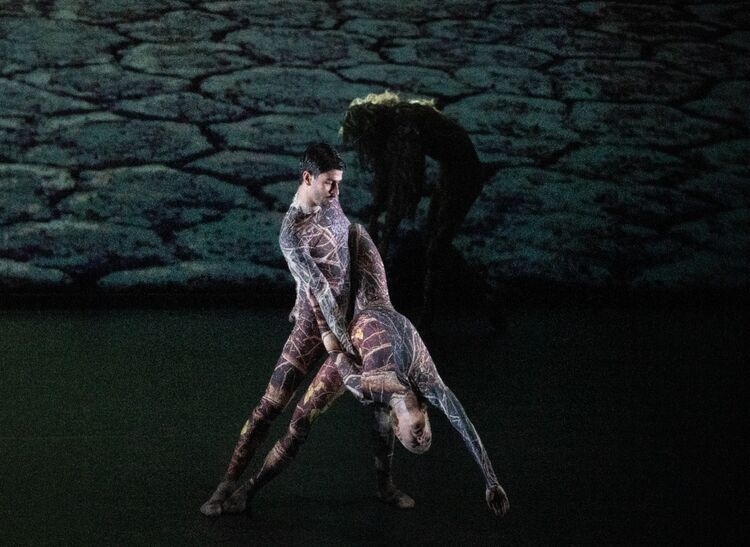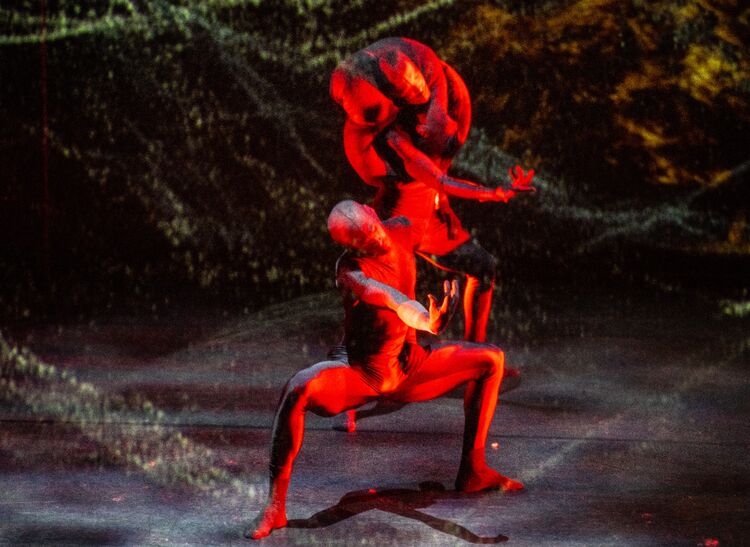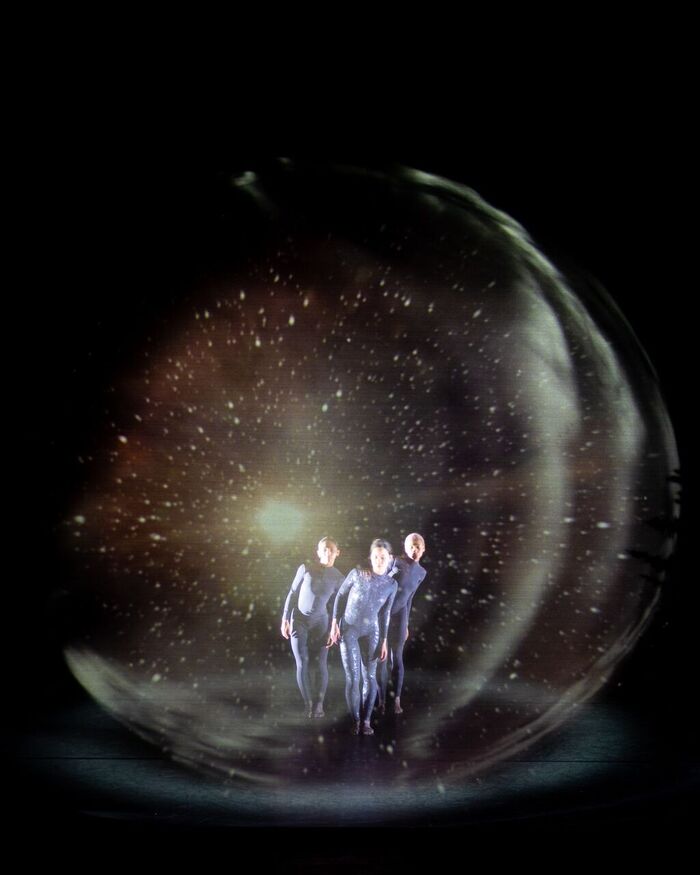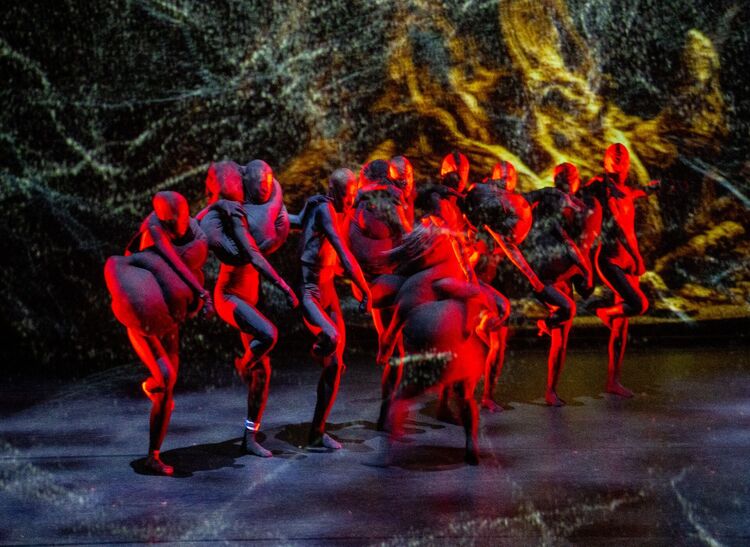UniVerse: A Dark Crystal Odyssey - A visually captivating journey through a multimedia universe
UniVerse: A Dark Crystal Odyssey is one of the latest works by the UK choreographer Wayne McGregor and his Company. Inspired by the fantasy film by Jim Henson, The Dark Crystal (1982), the piece is shaped by McGregor's fascination with the latest technology and visual, multimedia effects, and enhanced by an environmental appeal.
Almost from the very beginning, Wayne McGregor's work has been defined by two fundamental assets - a hyperkinetic, extravagant dance vocabulary and new technologies that both define the visuals and, to a large extent, determine the themes and inspirations. With time, they become increasingly more integral to the final creations, resulting in an inimitable, almost immaculately intertwined bundle of all on-stage elements giving the impression of one gigantic multimedia universe.
From this perspective, UniVerse: A Dark Crystal Odyssey is at its core the epitome and perfect case study of McGregor's work, which is rarely "just dance" in the sense of absolute immersion in only one (or one decidedly dominant) vehicle of expression. In doing so, the choreographer also actively pushes our understanding of what the fields of choreography and dance work are and broadens their very definition. Technologies, multimedia, visual effects, video projections, VR and other IT developments are extremely alluring for many artists and creators. They are constantly offering enhanced possibilities, new, unexplored and therefore compelling ways, they bring an innovative touch and have the ability to label the author as a true visionary. At the same time, however, it is all too easy to succumb to them to a degree at which one as an artist loses themselves, their perspective and artistic language, and let themselves be pulled by the superficial tinsel in one direction or the other, always merely scraping along the surface (note, for example, the Bohemian Gravity in the bpm triple bill by the Czech National Ballet, though it should be stressed that playing with the visual elements was probably the least of the work's issues). That is not the case with McGregor. His use of technologies, however extensive (of which the UniVerse itself is a prime example), doesn't give the impression of a kid in a toy store running around in a sugar rush. Not knowing what to try first, therefore grabbing at everything without a care in the world, as long as it's colourful, sparkly and ideally also makes a sufficiently obnoxious sound. Cooperation is the key. In McGregor's works there is an extraordinary blending of all the different voices that may be speaking their own specific language, but in a harmonious way and with a crystal clear, shared purpose. Which to me is the absolute manifestation of Wagner's theories of the Gesamtkunstwerk.
, Royal Opera House, London (2023), Photo credit Andrej Uspenski.jpg)
And while McGregor's work is shaped from the outside and the inside by clean structures and scientific ideas (cloning in Eden|Eden, the extraction of the human genome in Autobiography, artificial intelligence and the electrification of human movement in No One is and Island, semi-autonomous drones in +/- human, etc.), it is rarely emotionally inert or clinically cold. Even when the main role might be performed by robotic automatized arms or animations.
The emotional impact is also present in UniVerse, a scream about the grim state of the world, of nature and of human society, laced just lightly by an atmosphere of fantasy and images of mystical beings to which one could escape into safety.
Over the course of an intense seventy-five minutes, we follow a journey across the planet and the universe, from ocean depths to starry skies, from hazy mists to burning forests, from crystal lattices and pulsating amoebae to erupting solar flares. There is no single guiding light here; rather, it is a kaleidoscope of images chained together with varying degrees of apocalyptic intensity.
, Royal Opera House, London (2023), Photo credit Andrej Uspenski (1).jpg)
The music by Joel Cadbury does not deny the composer's involvement in the world of film and television. Its colour is quite opulent at times, but it is at its most powerful, and not ironically, in the more delicate moments, the quiet, almost intimate sections, where it has no need to prove anything to anyone. The score is complemented on several occasions by punchy excerpts from an original poem by Isaiah Hull, written by the poet as his reaction to the film The Dark Crystal, and specifically meant for McGregor's work. The unflinching narration adds to the despair and frustration; it is by no means a crutch or a mere word by word description.
The visuals are the most striking, coming from the experienced and trusted collaborators Lucy Carter (lighting design) and Ravi Deepres (videography). In the case of UniVerse, the video projection is truly honed to an immersive perfection. At all times, the stage is covered by a sheer drape that serves as a see-through projection screen, while another layer of the projection happens in the background. This results in a three-dimensional video effect that the dancers are an inherent part of, as are the projected objects that seemingly float through the depth of the stage. The illusion the eyes are sending back to one's brain is convincing to such a degree it at times provokes deliberate confusion as the brain struggles to rationalize and break the seen images down. There were times when I couldn't help but think that if we are constantly searching for and discussing the future of Czech Laterna magika as a multimedia theatre, this would appear to be at least one possible direction.
The work is a mosaic stained-glass window made up of panes of different degrees of luminosity - from brightly coloured and quite specific, palpable and uncomfortably realistic scenes to atmospherically obscured, metaphorical ones, which blend into each other as seamlessly as the various audiovisual and movement elements.
, Royal Opera House, London (2023), Photo credit Andrej Uspenski.jpg)
The dancing bodies transform, bend and swirl through space, the vocabulary perhaps more than ever before influenced by the classical ballet technique (if compared to other works by McGregor that were not originally created for a ballet company). Nevertheless, they do not lose the typical McGregor trademark style of fluidity combined with sharp edges, the sweeping movements of strong legs paired with relaxed, almost limp arms, intertwined duets and trios, origami-like jumps and bursts of frantic speed. Exceptionally striking is a dancer in black, who brings a new quality to the table - a liberation and softness, a never-ending stream of flowing motion patterns, and a mould that refers much more firmly to both the world of contemporary and street dance.
The tight-fitting costumes emphasize the bodies' curves, but not their gender. We are indeed talking about bodies that are androgynous, free of gender stereotypes, a fact that is imprinted in the dance vocabulary and partnering. The uniformity of the simple bodysuits of various colour patterns is significantly disrupted by two fantastical figures, whose otherness could be perceived as a representation of the two polarized races of Henson's The Dark Crystal. They are also perhaps most closely related to the particular visual design of the aforementioned pure puppet film, or the half action, half puppet Labyrinth (1986) by the same director.
Thus, at first glance and even at several others, it all seems the show is to be on an unquestionable road to success. The various elements of the piece clearly work well together, complement each other, and have a unified goal; none overrides the others, none is self-serving, cheap, or shallow. Only nothing in art is unquestionable, beginning with the art itself... But UniVerse: A Dark Crystal Odyssey ended up missing the most important thing. Impact. Yes, we do know the Earth is falling apart, and so is the human society. We know that the creative team aims to address, at times more metaphorically and at others more explicitly, the issues of ecology and the not so potential, but very much existing and ongoing environmental destruction. But such themes arguably should make one feel uneasy and uncomfortable, despite the actually peaceful and out-of-nowhere ending, which in more optimistic minds could presumably be interpreted as one of hope. And no such feeling resonates in me after the performance. There are many small details that have shown a great deal of promise, which I could touch on - the scene of a crackling, all-consuming fire, the sound effect of which, as you'll realize after a while, was created by the hissing and flapping of the performers' limbs; the scorching photograph on the projection, which grew progressively more and more real (I'm still not quite sure how); the trio depicting celestial constellations tracked by earth-based observatories from remote deserts; the sheer aggression of some scenes and the tender delicacy of others. But even all the promising leads multiplied together, failed to live up to their potential.
, Photo credit Andrej Uspenski (6).jpg)
The exceptional form has always been an inherent and defining element of McGregor's work, and for the most part he is very adept at infusing it with the desired meaning (whether one wants to think of it strictly rationally or emotionally), helped along by his dramaturg Uzma Hameed. It is only right that the choreographer has such an expert on his team. This time though, despite the urgency, the darkness and the contrast between fantasy and reality, which differences are ultimately not nearly as great as they might have seemed initially, it didn't quite work and the declared message was left only in the programme and the ideological concept.
Written from a performance on 15 March 2024, Sadler's Wells, London.
UniVerse: A Dark Crystal Odyssey
Choreography and direction: Wayne McGregor
Dramaturgy: Uzma Hameed
Music: Joel Cadbury
Film design: Ravi Deepres
Lighting design: Lucy Carter
Costumes and head pieces: Philip Delamore and Dr Alex Box
Spoken word artist: Isaiah Hull
World Premiere 13. 5. 2023



